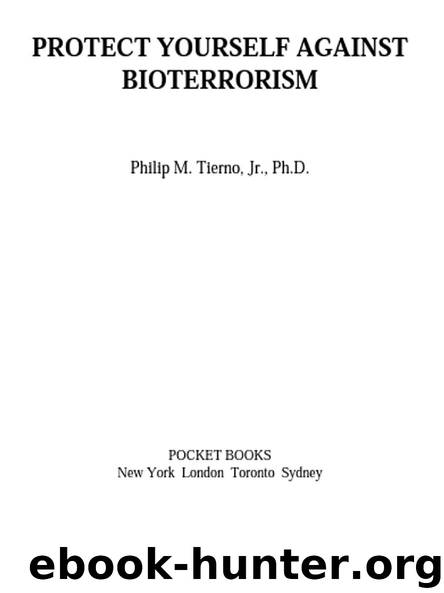Protect Yourself Against Bioterrorism by Philip M. Tierno Jr. Ph.D

Author:Philip M. Tierno, Jr., Ph.D.
Language: eng
Format: epub
Publisher: POCKET BOOKS
Published: 2002-07-15T00:00:00+00:00
8
CHOLERA
Bioterror Agent Vibrio cholerae
Type of Weapon Bacterium
Disease Caused Cholera
Transmissible (person-to-person) Rare
Incubation Period 4 hours to 5 days
Cardinal Features of Disease “rice water” stools, diarrhea without abdominal cramps
Treatment Antibiotics: doxycycline, ciprofloxacin, erythromycin
Vaccines Available Yes
HISTORY AND BACKGROUND
The causative agent of cholera is Vibrio cholerae, a short, curved, motile, gram-negative non-spore-forming bacillus. Two serogroups have been associated with human cholera infection, namely, 01 and 0139. The 01 group has two other biotypes—the “classical” and El Tor. The bacteria grow best at a neutral pH (7) but are able to tolerate an alkaline condition (pH 9).
Humans acquire the disease by consuming water or food contaminated with the organism. If a bioterrorist were to employ cholera bacteria as a weapon, they would most likely be used to contaminate water supplies. According to military experts, cholera is unlikely to be used in aerosol form.
The organism was first described and named by Pacini in 1854. Later Koch isolated the bacterium that he called “Kommabacillus” because of its characteristic comma or curved shape. Cholera bacteria don’t invade the intestinal mucosa, but rather they adhere to it. All strains of V. cholerae produce a protein enterotoxin that causes fluid loss in the small intestine but not the large intestine (colon), which is relatively insensitive to that toxin.
There have been seven pandemics (widespread epidemics) of cholera in recorded world history. The first pandemic, in 1816 to 1817, was followed by six others at intervals of about ten to fifteen years. The last occurred in 1961, involving the El Tor strain, whereas all of the others involved the “classical” strain.
In 1989, almost fifty thousand cases of cholera were reported to the World Health Organization from thirty-five countries, which attests to the widespread nature of the current pandemic. Most of these infections have occurred following ingestion of contaminated or poorly cooked seafood or water. Although wound infections have also been reported, these have followed a trauma of some sort, such as swimming or working in infected waters, or exposure to marine animals.
Cholera is endemic in India and Southeast Asia. From these centers cholera has been spread to other countries via shipping lanes. The seventh pandemic of the disease started in 1961 and caused disease in Asia, the Middle East, and Africa. Starting in 1991, the seventh pandemic spread to countries of South America and Central America. Although the disease is rare in North America since the 1800s, an endemic focus exists on the gulf coast of Louisiana and Texas.
The existence of V. cholerae outside the human gastrointestinal tract between epidemics and pandemics is uncertain. The bacteria may survive in a dormant state in brackish or salt water. Human carriers are known to exist but are thought to be uncommon.
V. cholerae produces several toxins and other virulence factors, but the cholera toxin (CT) is the most important of these. CT causes the mucosal cells of the small intestine to hypersecrete water and electrolytes into the lumen of the GI tract. This results in a profuse watery diarrhea, which can lead to severe dehydration syndrome.
Download
This site does not store any files on its server. We only index and link to content provided by other sites. Please contact the content providers to delete copyright contents if any and email us, we'll remove relevant links or contents immediately.
| Cell Biology | Developmental Biology |
| Entomology | Marine Biology |
| Microbiology | Molecular Biology |
| Biostatistics |
Sapiens: A Brief History of Humankind by Yuval Noah Harari(14252)
The Tidewater Tales by John Barth(12608)
Mastermind: How to Think Like Sherlock Holmes by Maria Konnikova(7227)
Do No Harm Stories of Life, Death and Brain Surgery by Henry Marsh(6891)
The Thirst by Nesbo Jo(6826)
Why We Sleep: Unlocking the Power of Sleep and Dreams by Matthew Walker(6618)
Life 3.0: Being Human in the Age of Artificial Intelligence by Tegmark Max(5474)
Sapiens by Yuval Noah Harari(5294)
The Longevity Diet by Valter Longo(5019)
The Body: A Guide for Occupants by Bill Bryson(4974)
The Rules Do Not Apply by Ariel Levy(4861)
The Immortal Life of Henrietta Lacks by Rebecca Skloot(4525)
Animal Frequency by Melissa Alvarez(4395)
Why We Sleep by Matthew Walker(4360)
The Hacking of the American Mind by Robert H. Lustig(4318)
Yoga Anatomy by Kaminoff Leslie(4306)
All Creatures Great and Small by James Herriot(4232)
Double Down (Diary of a Wimpy Kid Book 11) by Jeff Kinney(4207)
Barron's AP Biology by Goldberg M.S. Deborah T(4097)
